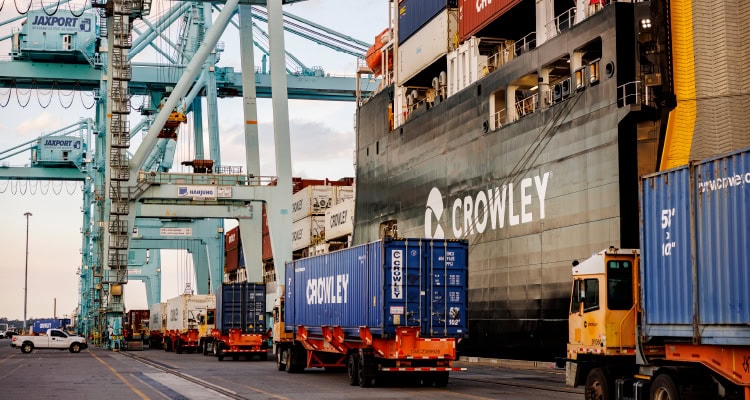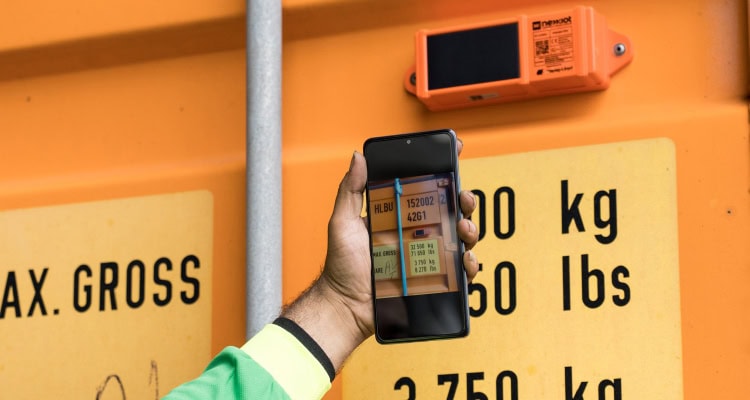Smart Sailing: Maritime Success Strategies

Faced with a complex wave of interconnected challenges, ocean carriers keep shipments on course by refining schedules, enhancing fleets, adding new technology tools, and introducing greener fuels.
“Our industry is facing a polycrisis environment,” says Trine Nielsen, vice president, global head of ocean freight at Flexport, a San Francisco-based global freight forwarder and non-vessel operating common carrier (NVOCC). Certainly, the challenges in ocean transportation flow from many directions these days.
Take the attacks by Yemen’s Houthi rebels on commercial shipping in the Red Sea. The situation has prompted shipping lines to forsake the route through the Suez Canal, detouring vessels in the Asia-Europe trade around South Africa.
“There is no additional capacity to deploy to the Cape of Good Hope routing, absorbing all normally planned buffer capacity,” says Ursula Wallace, director, ocean product, North America at SEKO, a forwarder and NVOCC in Schaumburg, Illinois. “Shipping lines try their best to ensure consistent service, but without having additional ships to deploy, schedules will continue to be impacted.”
These detours also affect transportation in other parts of the world. With vessels and containers tied up in longer transits, capacity is tight throughout the global shipping network, and rates have increased accordingly.
Ocean carriers and shippers are also keeping a nervous eye on looming future disruptions like port strikes. Concerned about getting products to market in time for the holiday season, many companies are booking space early, causing a demand spike.
Some shippers have pushed that spike even higher by double-booking the same cargo with different carriers to make sure they can secure the space they need. “Everyone thinks there’s twice as much demand, and the pricing goes up. It reinforces the panic,” Nielsen says. Double-booking also forces carriers to deal with last-minute cancellations and no-shows.
A Spectrum of Strategies
In the face of such varied, interconnected challenges, ocean carriers are doing their best to maintain their networks, provide containers where shippers need them, and offer sufficient space on vessels in order to deliver the best possible service.
The strategies shipping lines employ vary, as do the results. “Some carriers have been successful in deploying vessels at the right time, so they’ve not been constrained in how much cargo they could move out of Asia and into the United States, for example,” Nielsen says.
“Some carriers have been strategically positioned on how they’ve managed their ships,” she adds. “Other carriers have made sure equipment—the fleet of containers—is available where it needs to be.”
Equipment imbalances stem in part from the long detours around South Africa that keep containers on the water longer. To compensate, some carriers have purchased additional equipment.
To help carriers match capacity to demand as precisely as possible, Flexport tries to discourage shippers from double-booking, Nielsen says. At the same time, the company advises customers on how to make sure they can secure capacity and get cargo to its destination on time.
“For example, we have been advising customers to book earlier than they usually do, and plan very early for longer lead times,” she says.
Prepping for Scarce Supply

To ensure it can provide ample capacity to its shipper customers and to boost sustainability efforts, Crowley has added to its fleet four new vessels, all powered by liquid natural gas.
Vessel-owning carrier Crowley, based in Jacksonville, Florida, doesn’t have to worry about avoiding the Suez Canal. It serves shippers in the Caribbean and Central America, generally using smaller container vessels, with a capacity of 2,000 TEUs (twenty-foot equivalent units) or less.
But Crowley could also eventually feel the impact of the global capacity shortage, in part because it relies on chartered vessels for part of its fleet.
Currently, barely any vessels are available for charter in the Caribbean region. And with scarce supply, charter rates are likely to go up.
“We are a bit insulated from short-term swings, but if there’s a long-term impact on the charter market, we will be impacted,” says Brett Bennett, senior vice president and general manager of the Crowley logistics division.
Crowley is compensating by buying more ships of its own. In 2023, the company ordered four new vessels of about 1,400 TEUs each, powered by liquid nitrogen gas (LNG).
“That’s part of our sustainability journey,” Bennet says. “But it also gives us additional capacity and capabilities to serve our customers. And it further insulates us from a volatile charter market.”
Crowley also maximizes its existing capacity by using its own Crowley Engineering Services to manage its ships. “We invest in our vessels and keep them operating top-notch,” Bennett says.
Besides transporting goods with its own fleet within its own service area, Crowley also serves as an NVOCC. It partners with global ocean carriers to ship cargo between its own service footprint and other parts of the world.
In that role, as of September 2024, Crowley was also keeping its eye on the labor dispute on the East and Gulf Coasts and routing to the U.S. West Coast when possible. That’s not a panacea, though.
“We’ve seen in the past that the U.S. West Coast, as big as it is, can get quickly congested,” Bennett says.
Visibility Solutions Are Key

Hapag-Lloyd’s visibility solutions and services enable more effective container tracking and help recover stolen cargo.
With greater complexity in ocean transport, it’s especially important for shippers to monitor the status of cargo in transit. To meet that need, global ocean carrier Hapag-Lloyd recently introduced Live Position, a service that lets shippers and supply chain partners know where their containers are, with updates every 15 minutes.
Shippers already get this information from ocean carriers while containers are at sea. But as various trucking, rail, or barge companies take charge of containers, those providers might or might not offer updates.
“There’s a big black hole in terms of everything that happens to a container while it’s on the inland journey,” says Olaf Habert, director, strategy office at Hapag-Lloyd.
Hapag-Lloyd can fill that hole because it places tracking devices on all of its containers. No matter where in the world a shipment is, or what transportation mode it’s using, if it’s inside a Hapag-Lloyd container, the ocean carrier can track its location and share that data with shippers and intermediaries through its website.
Hapag-Lloyd is also developing an application programming interface (API) so shippers, logistics partners, and solution developers can integrate the location data into their own systems.
Besides simply monitoring a shipment’s progress, Live Position can help recover cargo when something goes wrong. If a marine terminal loses track of a customer’s container while it is parked in the port, for instance, Hapag-Lloyd can identify the container’s location with Live Position, making it quick and easy for the terminal to recover it.
At a time when cargo theft is all too common, Live Position can also help recover freight when thieves, masquerading as legitimate drayage drivers, make off with containers.
“We’ve been able to chase down these containers and help law enforcement get them back,” Schmidt says.
Crowley also uses digital technology to give customers better insights into their shipments. For instance, it has developed a container availability tool, powered by AI and machine learning.
Cutting Carbon
As ocean carriers and shippers navigate a complex transportation environment, they also need to consider their impact on the earth’s physical environment.
Some of Crowley’s latest efforts to reduce emissions focus on its vessels’ hulls. “We look at the latest coatings to put on the bottom of the ships to reduce emissions and keep them running as efficiently as possible,” says Bennett.
The company is also piloting the use of robotic devices that clean marine growth off the ship as it travels. “That can make the vessel anywhere from 7% to 12% more fuel efficient,” he says.
As part of its drive to reach net-zero carbon emissions by 2040, Danish shipping company A.P. Moller-Maersk is renewing its fleet of large container ships with 24 new vessels that incorporate dual-fuel engines. These ships can run on bio-methanol as well as on traditional marine fuel, helping to reduce carbon footprint.
By 2027, Maersk expects to have 25 large, dual-fuel vessels on the water. At that point, Maersk’s greenhouse gas abatement will equal about 3 million tons, says a company spokesperson.
With additional orders in the future, Maersk plans to bring its total dual-fuel fleet to between 50 and 60 vessels, including both owned and chartered ships, with a total capacity of 800,000 TEUs.
Before Maersk began deploying ships that run on bio-methanol, the company used other biofuels and gave shippers the chance to decarbonize their supply chains through a service called ECO Delivery.
“ECO Delivery gives customers the ability to choose to ship their ocean cargo with lower carbon fuels,” says a Maersk spokesperson. The carrier uses a chain of custody model called “mass balance” to offer ECO Delivery on all its routes.
“Even if a specific vessel is not using ECO Delivery fuel, other vessels in the network are, and those emissions savings are attributed to the ECO Delivery customer,” he says.
In 2024, Maersk added ECO Delivery Inland, which uses electric trucks for drayage service, in several U.S. markets.
Although today’s global transportation marketplace often churns up rough seas, the solutions that carriers bring to bear can help companies keep their shipments on course.
Ports Move Ahead With Upgrades
As ocean carriers add new services and technology tools to keep cargo flowing, U.S. ports are working to improve the transfer of goods between land and sea.
For instance, the Port Authority of New York and New Jersey committed $82 million in 2024 to two major upgrade projects. In one initiative, worth $50 million, the Port Authority and the Army Corps of Engineers are performing berth maintenance dredging, berth rehabilitation, and berth construction. In the second, the Port is investing $32 million to widen its Gravesend Anchorage and deepen it from 47 feet to 50 feet. This will provide new anchorage space for the largest container ships, say port officials.
In April 2024, the Port of Brownsville, Texas received $1.1 million from the U.S. government to fund its Port of Brownsville Suitability Analysis and Feasibility project. This study will lay the groundwork for a series of infrastructure improvements aimed at receiving larger vessels efficiently and safely.
The Port of Galveston broke ground in July 2024 on $90 million in construction to improve and expand its West Port Cargo Complex. This will give the port 30 new acres of cargo-handling space and a new berth. The port will also enclose two obsolete slips and demolish an old grain elevator, making more space for roll-on/roll-off cargo, wind turbine components, and other cargo.
A $3 million grant from the California Department of Transportation will help the Port of Oakland and the City of Oakland develop a plan to mitigate the risk of flooding from sea level rise and groundwater intrusion. A second $3 million grant from the state will help the port develop its Port Integrated Data Environment, a platform to unite various digital services to improve cargo flow and visibility.
The Port of Virginia is continuing work on its $650 million project, launched in 2023, to renovate the North Berth at Norfolk International Terminals, creating three terminals capable of handling the world’s largest cargo ships. The port is also preparing to open a new, 55-foot deep shipping channel in 2025. This channel is estimated to be the deepest on the U.S. East Coast.
